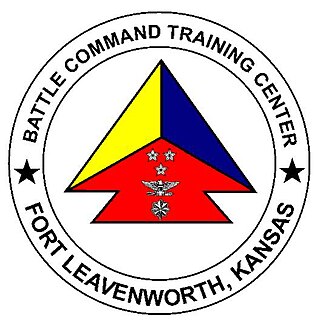
The School of Advanced Military Studies (SAMS) is one of four United States Army schools that make up the United States Army Command and General Staff College (CGSC) at Fort Leavenworth, Kansas. This "enormously rigorous" graduate school comprises three programs: the larger Advanced Military Studies Program (AMSP); the Advanced Strategic Leadership Studies Program (ASLSP), a Joint Military Professional Education II certified senior service college program for senior field-grade officers, and the Advanced Strategic Planning and Policy Program (ASP3), which supports officers in obtaining doctorates from civilian schools.

Fort Bliss is a United States Army post in New Mexico and Texas, with its headquarters in El Paso, Texas. Named in honor of LTC William Bliss (1815–1853), a mathematics professor who was the son-in-law of President Zachary Taylor, Ft. Bliss has an area of about 1,700 square miles (4,400 km2); it is the largest installation in FORSCOM and second-largest in the Army overall. The portion of the post located in El Paso County, Texas, is a census-designated place with a population of 8,591 as of the time of the 2010 census. Fort Bliss provides the largest contiguous tract of restricted airspace in the Continental United States, used for missile and artillery training and testing, and at 992,000 acres boasts the largest maneuver area. The garrison's land area is accounted at 1.12 million acres, ranging to the boundaries of the Lincoln National Forest and White Sands Missile Range in New Mexico. Fort Bliss also includes the Castner Range National Monument.
Fort Gregg-Adams, in Prince George County, Virginia, United States, is a United States Army post and headquarters of the United States Army Combined Arms Support Command (CASCOM)/ Sustainment Center of Excellence (SCoE), the U.S. Army Quartermaster School, the U.S. Army Ordnance School, the U.S. Army Transportation School, the Army Sustainment University (ALU), Defense Contract Management Agency (DCMA), and the U.S. Defense Commissary Agency (DeCA).

The United States Army Command and General Staff College at Fort Leavenworth, Kansas, is a graduate school for United States Army and sister service officers, interagency representatives, and international military officers. The college was established in 1881 by William Tecumseh Sherman as the School of Application for Infantry and Cavalry, a training school for infantry and cavalry officers. In 1907 it changed its title to the School of the Line. The curriculum expanded throughout World War I, World War II, the Korean War, and the Vietnam War and continues to adapt to include lessons learned from current conflicts.

Fort Leavenworth is a United States Army installation located in Leavenworth County, Kansas, in the city of Leavenworth. Built in 1827, it is the second oldest active United States Army post west of Washington, D.C., and the oldest permanent settlement in Kansas. Fort Leavenworth has been historically known as the "Intellectual Center of the Army."

The Naval Postgraduate School (NPS) is a public graduate school operated by the United States Navy and located in Monterey, California.
Staff colleges train military officers in the administrative, military staff and policy aspects of their profession. It is usual for such training to occur at several levels in a career. For example, an officer may be sent to various staff courses: as a captain they may be sent to a single service command and staff school to prepare for company command and equivalent staff posts; as a major to a single or joint service college to prepare for battalion command and equivalent staff posts; and as a colonel or brigadier to a higher staff college to prepare for brigade and division command and equivalent postings.

The U.S. Army Combined Arms Support Command (CASCOM) is a major subordinate command of the U.S. Army Training and Doctrine Command (TRADOC) and is located at Fort Gregg-Adams, Virginia. Subordinate to CASCOM is the Sustainment Center of Excellence (SCoE), which oversees and coordinates the five sustainment branches of the Army and the Army Sustainment University. The commander of CASCOM is dual-hatted as the head of SCoE. The CASCOM commander also serves as the commander of Fort Gregg-Adams.

The U.S. Army Combat Capabilities Development Command Army Research Laboratory is the U.S. Army's foundational research laboratory. ARL is headquartered at the Adelphi Laboratory Center (ALC) in Adelphi, Maryland. Its largest single site is at Aberdeen Proving Ground, Maryland. Other major ARL locations include Research Triangle Park, North Carolina, White Sands Missile Range, New Mexico, Graces Quarters, Maryland, and NASA's Glenn Research Center, Ohio and Langley Research Center, Virginia. ARL also has regional sites in Playa Vista, California, Chicago, Austin, TX, and Boston.

The U.S. Army Combined Arms Center (USACAC) is located at Fort Leavenworth and provides leadership and supervision for leader development and professional military and civilian education; institutional and collective training; functional training; training support; battle command; doctrine; lessons learned and specified areas the Commanding General, United States Army Training and Doctrine Command (TRADOC) designates in order to serve as a catalyst for change and to support developing relevant and ready expeditionary land formations with campaign qualities in support of the joint force commander.

The U.S. Army Test and Evaluation Command, or ATEC, is a direct reporting unit of the United States Army responsible for developmental testing, independent operational testing, independent evaluations, assessments, and experiments of Army equipment.
A military building is any structure designed to house functions performed by a military unit. General types include:
During World War II, Kansas was a major United States Army Air Forces (USAAF) training center for pilots and aircrews of USAAF fighters and bombers. Kansas was favored because it has excellent, year-round flying conditions. The sparsely populated land made ideal locations for gunnery, bombing, and training ranges.

The United States Army Sustainment University is the Army's center of sustainment training for Department of Defense military and civilian personnel pursuing Professional Military Education (PME) and other associated training in military logistics and sustainment. The Army Sustainment University (ASU) has two campuses. The Somervell Campus at Fort Gregg-Adams, Virginia, delivers sustainment leader education for Quartermaster, Ordnance, and Transportation Soldiers and civilians. The Adams Campus at Fort Jackson, South Carolina, includes the Soldier Support Institute, which delivers Adjutant General and Financial Management leader education. ASU is a subordinate command to the United States Army Combined Arms Support Command, and is located at Fort Gregg-Adams, Virginia. The current President of Army Sustainment University is Ms. Sydney A. Smith, Senior Executive Service.

Battle Command Training Center - Leavenworth (BCTC-Lvn) provides battle command and staff training, training support, and publications to Army National Guard Soldiers and units, at its facility in Fort Leavenworth, Kansas, USA, or via mobile training teams, prior to mobilization to assist them prepare for full-spectrum operations in a joint, interagency, intergovernmental, and multinational environment.

The United States Army Futures Command (AFC) is a United States Army command that runs modernization projects. It is headquartered in Austin, Texas.

John Michael “Mike” Murray is a retired United States Army general, the first commanding general of United States Army Futures Command (AFC), a new four-star Army Command (ACOM) headquartered in Austin, Texas. Murray was previously the G-8, a deputy chief of staff to the Chief of Staff of the United States Army (CSA). As G-8, Murray served as the principal advisor to the CSA for materiel requirements, as military counterpart to the Assistant Secretary of the Army for acquisition, logistics, and technology.

The United States Army Acquisition Corps (AAC) is the officer / NCO corps of the United States Army Acquisition Workforce (AAW), a branch which includes civilians, officers, and NCOs. The Acquisition Corps is composed of army officers who serve in acquisition, a specialized form of product development, fielding, and support and Noncommissioned Officers who specialize in Contracting, Level I Program Management and Purchasing. These officers begin their careers in the other branches of the army for eight years, after which they may elect the Acquisition branch as their career as assistant program managers (APMs), program managers (PMs), and program executive officers (PEOs). The Noncommissioned Officers (NCOs) are reclassified in the Army Acquisition NCO Corps after serving 7-10 years in their respective enlisted career management fields, and serve primarily in the Army Acquisition Career Management Field - 51 and (MOS) 51C. 4% percentage of the Army Acquisition Officers serve among the 40,000 members of the army acquisition workforce, 6% in MOS 51C - Acquisition, Logistics and Technology Contracting Noncommissioned Officer, and the remainder 90% percentage consist largely of Department of the Army civilians.

Eric J. Wesley is the CEO of Parasanti Inc. a developer of intelligent edge software enabling data and workload orchestration and internet of things connectivity in low and no bandwidth environments. Wesley is a former United States Army Lieutenant General who retired from the U.S. Army on September 1, 2020. He serves on a number of boards and advisory positions for combat vehicle development, advanced nuclear power, and Joint All Domain Command and Control. He is a public speaker and a member of the Council on Foreign Relations.
The Vulnerability Assessment Laboratory (VAL) was a research institution under the U.S. Army Materiel Command (AMC) that specialized in missile electronic warfare, vulnerability, and surveillance. It was responsible for assessing the vulnerability of Army weapons and electronic communication systems to hostile electronic warfare and coordinating missile electronic countermeasure efforts for the U.S. Army. VAL was one of the seven Army laboratories that merged to form the U.S. Army Research Laboratory (ARL) in 1992.















